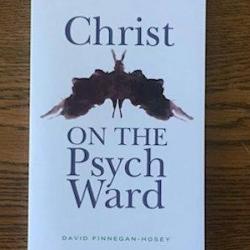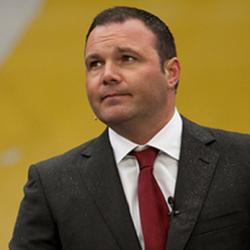I wonder how many other men out there feel as unmanly as I do. Every time I’m at a kid’s soccer game or a Cub Scout campout, I find myself surrounded by a bunch of guys in Oakleys who are bigger, stronger, and more confident than I am. I’d like to think that some of them have the same insecurities when they’re around other men. I wonder how many men would be liberated and healed if we got together to read Nate Pyle’s new book Man Enough. Unlike most Christian books about manhood, it doesn’t tell us the one right way to be a man. It creates the space for men to be vulnerable with one another and name the pressures that are eating us alive.
There’s been a lot of hand-wringing in recent years about a “crisis” for masculinity in America. Because of the strides of feminism, men have seemed to lose their relevance. Former megachurch pastor Mark Driscoll infamously built his empire off of this sense that men need to fight back against our culture’s attempts to “feminize” them and reclaim their authority in their homes and churches. To Nate Pyle, the masculinity crisis has a different source: “Masculinity is not under crisis because of feminizing, but it is in trouble because it is, more often than not, defined by what it is not rather than by what it is. Real men don’t cry. Real men don’t back down from a fight” (47).
I remember the terror I felt as a boy of being accused of throwing or running or dancing like a girl. Now I’ve got sons of my own. I’m not sure that growing up as a boy is any better today than when I was growing up. It seems like kids’ sports culture is much more fiercely competitive than it ever was in the eighties because of helicopter parenting. So if you’re a boy who’s not a jock, you pretty much don’t have an identity. How can I raise my sons to know that they are man enough regardless of what their gifts and interests are?
Like most Christian authors, Nate exhorts us to look to Jesus as a model for masculinity. But instead of manufacturing a masculine Jesus in reaction to the perceived feminization of Jesus by the church, Nate writes that we should allow ourselves to be scandalized by Jesus’ apparent weakness. He looks at one of the most important metaphors for Jesus, the lamb who was slain.
Imitating Jesus begins when we are willing to be slain. Willing to be raked over the coals. Willing to be seen as weak. Very few men will say, “I want to be known as a lamb.” But what does it say that Jesus was willing to be seen as a lamb? It seems he is redefining not only masculinity but strength as well. Jesus reveals that what we think is weak is actually strong. If we were to define masculinity by this Jesus, we would have to admit that masculine stregnth is not the ability to defeat one’s enemies with a show of raw power, but masculine strength that imitates the actions of Jesus is the willingness to play down one’s life for another — including for the lives of one’s enemies. [89]
To be willing to be a weak lamb like Christ means paradoxically having enough emotional and spiritual security to allow your strength to be called into question. All the pageantry of machismo culture is a byproduct of fear and shame. For Nate, the goal of healthy masculinity is not to conform to one particular way of being a man, but to be authentically human. When the goal shifts like that, there’s no reason to fear and belittle “girliness.” Nate writes: “What if men are able to be so secure in their masculinity that strong women are seen not as a threat to their manhood but as a crucial ally in the quest of both men and women to become more human?” (172).
Nate’s book has been great for me in a season in which I’m trying to process and heal from some of my wounds as an unmanly-feeling man. It doesn’t claim to offer brilliant, earth-shattering answers so much as creating the space for men to ask taboo questions about themselves. Throughout the book, Nate teaches vulnerability by modeling it with examples from his own life. The only thing better than reading this book by myself would be to read it with a group of guys, which is something I plan to do in the near future. You should too!

![Nate Pyle [from natepyle.com]](https://wp-media.patheos.com/blogs/sites/447/2015/10/nate-pyle-2.jpg)











